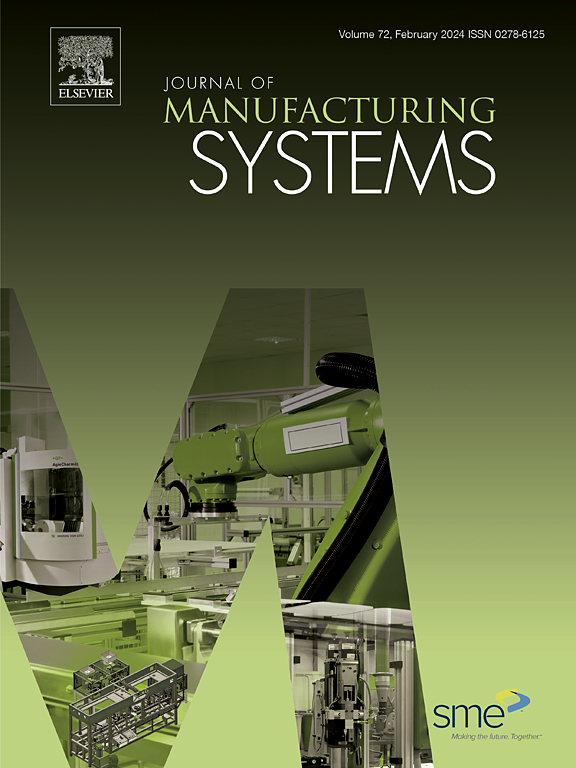具有嵌入式知识的时空双流融合网络:刀具磨损监测的过程广义框架
IF 14.2
1区 工程技术
Q1 ENGINEERING, INDUSTRIAL
引用次数: 0
摘要
刀具磨损监测是智能数控系统中的一项关键技术,对加工稳定性、产品质量和生产效率有着重要的影响。然而,刀具磨损过程的复杂性和随机性对传统的单模型方法提出了重大挑战。这些方法通常难以捕获不同的数据模式,导致精度低和处理泛化差。本研究提出一种具有嵌入式知识的时空双流融合网络(STDSFnet)。该框架建立了多模态传感器数据与刀具磨损状态之间的强相关性。该方法包括三个关键步骤:(1)利用Spearman相关分析选择敏感特征向量,减少瞬态信号干扰;(2)建立双流网络提取时空磨损相关信息;(3)集成协调注意机制和特征融合模块,增强特征表征,从而提高TWM的精度和处理泛化。此外,为了保证TWM结果的趋势符合实际磨损模式,引入了领域知识,提高了监测结果的可靠性和可解释性。实验验证了STDSFnet在块状不锈钢工件和碳纤维增强聚合物(CFRP)加工场景下的有效性。与基线方法相比,STDSFnet使RMSE降低38.94 % -62.04 %,MAE降低43.64 % -61.70 %,R²提高4.96 % -28.59 %。这些结果证实了深度集成的时空融合可以显著提高TWM的精度和可靠性。本文章由计算机程序翻译,如有差异,请以英文原文为准。
Spatial-temporal dual-stream fusion network with embedded knowledge: A process-generalized framework for tool wear monitoring
As a pivotal technology in intelligent computer numerical control (CNC) systems, tool wearing monitoring (TWM) significantly influences machining stability, product quality, and production efficiency. However, the complexity and randomness of the tool wear process pose significant challenges to traditional single-model methods. These methods often struggle to capture diverse data patterns, leading to low accuracy and poor processing generalization. This study proposes a Spatial-Temporal Dual Stream Fusion Network (STDSFnet) with embedded knowledge. The framework establishes strong correlations between multi-modal sensor data and tool wear states. The methodology consists of three key steps: (1) applying Spearman correlation analysis to select sensitive feature vectors, which helps reduce transient signal interference; (2) developing a dual-stream network to extract spatial and temporal wear-related information; and (3) integrating coordinated attention mechanisms and feature fusion modules to enhance the feature representation, thereby improve the TWM accuracy and processing generalization. Besides, to ensure that the trend of TWM results conforms to the actual wear pattern, domain knowledge is introduced to improve the reliability and interpretability of monitoring results. Experiments validate the effectiveness of STDSFnet on block-shaped stainless-steel workpieces and carbon fiber-reinforced polymer (CFRP) machining scenarios. Compared to baseline methods, STDSFnet reduces RMSE by 38.94 %–62.04 %, decreases MAE by 43.64 %–61.70 %, and improves R² by 4.96 %–28.59 %. These results confirm that spatial-temporal fusion with deep ensembles significantly boosts TWM accuracy and reliability.
求助全文
通过发布文献求助,成功后即可免费获取论文全文。
去求助
来源期刊

Journal of Manufacturing Systems
工程技术-工程:工业
CiteScore
23.30
自引率
13.20%
发文量
216
审稿时长
25 days
期刊介绍:
The Journal of Manufacturing Systems is dedicated to showcasing cutting-edge fundamental and applied research in manufacturing at the systems level. Encompassing products, equipment, people, information, control, and support functions, manufacturing systems play a pivotal role in the economical and competitive development, production, delivery, and total lifecycle of products, meeting market and societal needs.
With a commitment to publishing archival scholarly literature, the journal strives to advance the state of the art in manufacturing systems and foster innovation in crafting efficient, robust, and sustainable manufacturing systems. The focus extends from equipment-level considerations to the broader scope of the extended enterprise. The Journal welcomes research addressing challenges across various scales, including nano, micro, and macro-scale manufacturing, and spanning diverse sectors such as aerospace, automotive, energy, and medical device manufacturing.
 求助内容:
求助内容: 应助结果提醒方式:
应助结果提醒方式:


